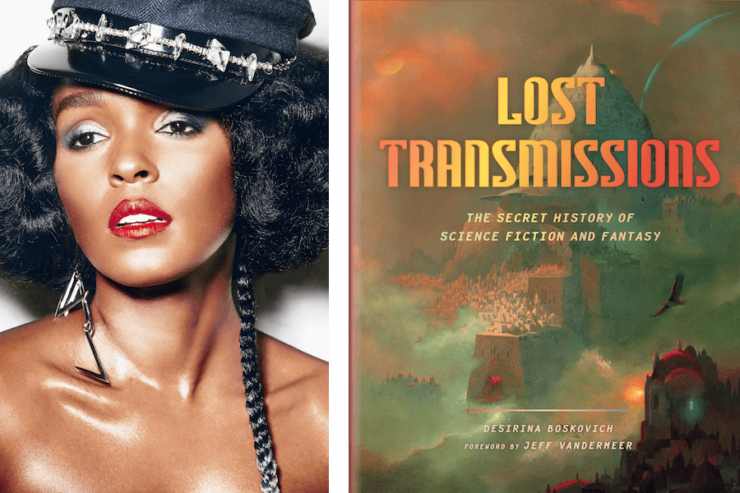We’re excited to share an excerpt from LaShawn M. Wanak’s essay “Metropolis Meets Afrofuturism: The Genius of Janelle Monáe”. The essay appears in Lost Transmissions, a fascinating illustrated history of lost, overlooked, and uncompleted works of science fiction and fantasy —available now from Abrams Books.
Metropolis Meets Afrofuturism: The Genius of Janelle Monáe
A dark alley behind an apartment complex in Neon Valley Street. Two figures running hand in hand, one human, the other android. The buzz of chainsaws and the crackle of electro-daggers. This evocative image begins the tale of Cindi Mayweather, spun in lyrical form by Janelle Monáe: songstress, poet, dreamer, prophet, feminist, Afrofuturist.
To listen to Janelle Monáe is to immerse oneself into an audio-cinematic experience. From her debut EP Metropolis to her current album Dirty Computer, Monáe’s songs sweep through genres with the ease of donning clothes: crooned ballads, punk rock screamfests, bubblegum pop, swelling orchestral arias, blistering rap. Through it all, science fiction wends like a pulsing heartbeat. Fritz Lang’s Metropolis influences the creation of Neon Valley Street, with Monáe adopting its titular poster image for her album cover of ArchAndroid. There are references to electric sheep, time travel, and a prophecy about a cyborg messiah who will unite the whole world.
“I thought science fiction was a great way of talking about the future,” Janelle Monáe told Bust Magazine in a 2013 interview. “It doesn’t make people feel like you’re talking about things that are happening right now, so they don’t feel like you’re talking down to them. It gives the listener a different perspective.”
But Monáe doesn’t just borrow science-fiction motifs. She rewrites them in Afrofuturistic terms that reflect her own experiences as a black, queer woman trying to survive in a world that sees little value in her. Metropolis and ArchAndroid particularly explore how androids are used as stand-ins for the marginalized and the oppressed. Monáe joins the ranks of other black music artists who have blended science fiction into their works: George Clinton/Parliament, Sun Ra, Missy Elliott. But Monáe stands out as having a single narrative span across several albums—that of Monáe’s alter ego, Android 57821, otherwise known as Cindi Mayweather.
Cindi Mayweather is an android who has committed the sin of falling in love with a human. Monáe tells her story in fragments, in music lyrics, and music videos. Throughout Metropolis, Cindi runs from bounty hunters, gets captured, and languishes in cybertronic purgatory. In the video for the song “Many Moons,” she is programmed to sing at an android auction, where she experiences a strange power that levitates her, then shorts her out. In ArchAndroid, she discovers that she may be the archangel who could save the world. In the video for “Tightrope,” a tuxedo-clad Cindi causes an almost-successful rebellion in The Palace of the Dogs asylum. In The Electric Lady, considered a prequel to ArchAndroid, Cindi is still on the run, known as Our Favorite Fugitive.
The story is fragmented, and may in some cases contradict itself, but Monáe keeps it going by framing the narrative in suites numbered I through V (much like a science fiction series). She also fleshes out Cindi’s story through music videos, liner notes, Websites, motion picture treatments (music video concepts in written form), and even short films and fan art put out by Monáe and her producers at Wondaland Records. All of this is woven into a cohesive narrative that not only works, but also gives glances into a richer world full of intrigue, drama, love, loss, and revolution.
Monáe’s use of Cindi Mayweather brings to mind Ziggy Stardust, David Bowie’s alter ego and subject of his fifth album, The Rise and Fall of Ziggy Stardust and the Spiders from Mars. His album features a bisexual, androgynous being who was sent as a messenger from extraterrestrials and is used by Bowie to explore sexual themes and social taboos. In Bowie’s case, however, he did not want to be continually defined by Ziggy and dropped the persona. Janelle Monáe could have done this as well, but rather than fade Cindi Mayweather into obscurity, Monáe chose to continue the narrative of Android 57821 by taking a new direction—utilizing clones of herself.
Monáe’s clones populate her album covers and videos: strutting at android auctions, serving as waitresses and newscasters, dancing in unison, causing small rebellions that fail. Some of these clones have names—the album cover of Electric Lady is depicted as a painting of Cindi Mayweather and her “sisters”: Andromeda, Andy Pisces, Catalina, Morovia, and Polly Whynot. Monáe can then shift her narrative while remaining in keeping with the android universe she’s created. This is most prevalent in Dirty Computer, where we are introduced to Jane 57821, who shares the same number as Cindi Mayweather, but is older, less naïve, and more of a revolutionary than a messiah. This reflects Monáe’s own change as she becomes more open about her pansexual identity, as well as responding to the #BlackLivesMatter and #MeToo movements. Even the music style shifts from the angelic crooning of Cindi Mayweather in ArchAndroid to the throatier rasp of Jane/Janelle in Dirty Computer.
It’s a brilliant strategy. In having multiples selves, Monáe can expand upon the worldbuilding of her narrative, told in multiple viewpoints but all originating from herself. She is not locked into a single narrative, but is able to explore all facets of her self-identity, from her queerness to her blackness to her religious faith. This makes Monáe not only an excellent musician, but also an amazing storyteller, one who is telling a science fiction story in real time.
In her SyFy Wire article “Octavia Butler and America as Only Black Women See It,” Tari Ngangura wrote, “It is a rare writer who can use sci-fi not simply to chart an escape from reality, but as a pointed reflection of the most minute and magnified experiences that frame and determine the lives of those who live in black skin.” Through her music, the story of Cindi Mayweather/Django Jane/Janelle Monáe is bringing people who have been in separate worlds—science fiction enthusiasts, the hip-hip community, queer folk—and uniting them in a shared universe just as diverse as her musical styles.
Buy the Book


Lost Transmissions
“Metropolis Meets Afrofuturism: The Genius of Janelle Monáe” © 2019 by LaShawn M. Wanak.
Excerpted from Desirina Boskovich’s Lost Transmissions; Reprinted with permission from Abrams.
Janelle Monáe press photo/artwork © by Atlantic Records.










